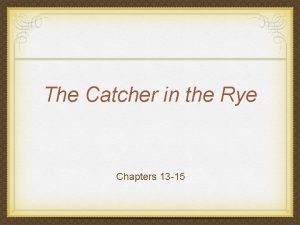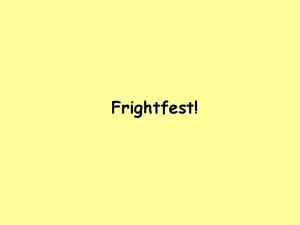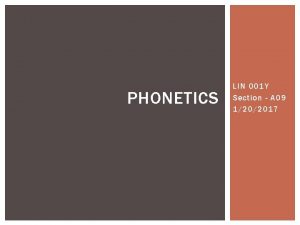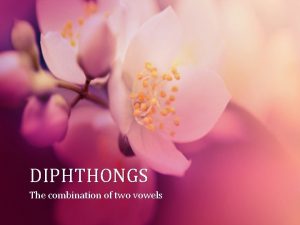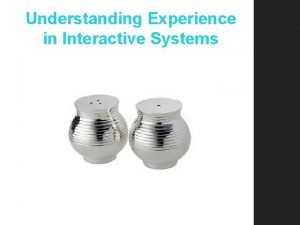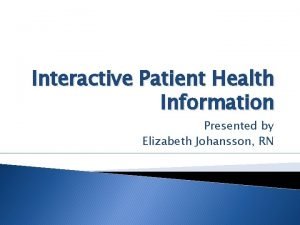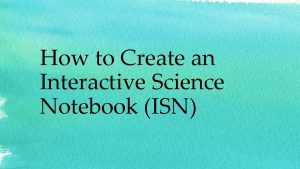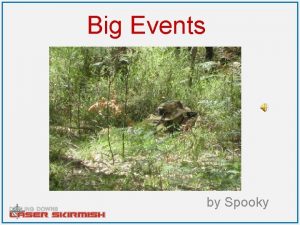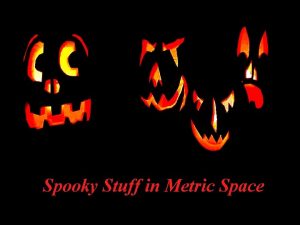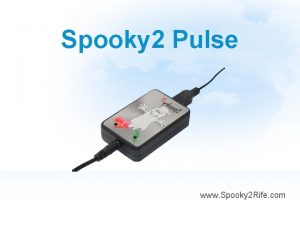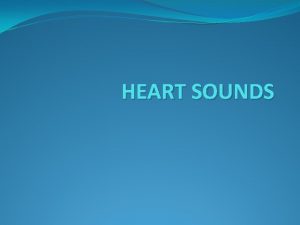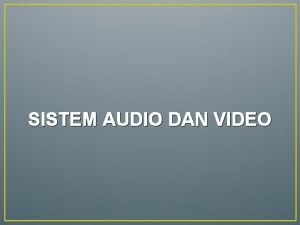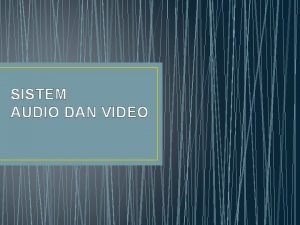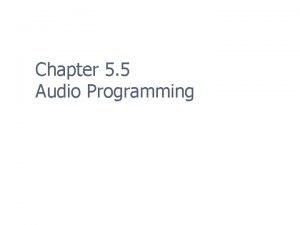Spooky Sounds Interactive Audio Systems and Design for













- Slides: 13

Spooky Sounds: Interactive Audio Systems and Design for a Themed Attraction In An Academic Environment Bruce Ellman & John Huntington New York City College of Technology

History • The Gravesend Inn started out as a small project in 1999 and has grown into the department's "signature" production, with the audience growing from a few dozen to over 2000 annually. The attraction is designed by faculty members and installed each year by teams of students, and has evolved to cover two floors and more than a dozen rooms.

Interactivity • Through the use of show control technology, the audience triggers the system as they walk through, and the sound system has to be designed to accommodate this. Stage Research’s SFX software was chosen because it’s easily controlled via telnet commands.

System Architecture Evolution 1 • The 2008 Haunted Hotel audio setup consisted of two independent systems running Stage Research’s SFX playback software. Amplifiers and self-powered speakers were fed analog signal directly from the outputs of multiple Mark of the Unicorn 2408 audio interfaces utilized in each of the systems. Multicables were run from the computer to several amplifier racks. • Bruce Ellman came on as sound designer in 2009. Because of time restraints the same system as in 2008 was used so that first year was used to find a narrative structure for the event, add a few new effects, and upgrade some existing effects. Many of the pre-2009 design effects are still heard in the attraction. David Smith has composed new music to go with his earlier work that further helps advance the narrative.

Design Philosophy: Narrative Structure The narrative structure that’s been devised has the audience flow through a historical timeline. “Themes” based on variations of music and effects are established and link Zones. The Gravesend Inn audio design is now divided into five major Zones: • The Lobby – The attraction entrance / audience loading area. This area design is the front of an old dilapidated hotel at a seashore retreat. • The Underbelly/Pirate zone – There is a transitional staircase down to this area which begins with a stand-alone animatronic pirate. There are other rooms along this passage. • Numbered Suites zone – There are stairs up to a demonic boiler and a row of numbered suites. • Main Rooms / Stage – Contains a maze-like route as the journey moves forward in time and other hauntings. These rooms include a dining chamber, a bedroom, and a conservatory (2011). • The Audience Area – Audience exits from the stage into the auditorium where they can watch the current guests making their way through the attraction.

System Architecture Evolution 2 • The audio system started as a hodge-podge of various technologies and utilized a dual system setup. The new narrative approach begun in 2009 presented challenges trying to synchronize themes between zones covered by two different system. • In 2010 the audio system underwent a significant redesign. All effects were produced from a single SFX computer and were routed digitally from the optical ADAT outputs of two MOTU 2408 units into a Yamaha PM 5 D console fitted with two ADAT cards. A Cobranet card was fitted in a third PM 5 D slot to feed a Yamaha DM -1000 console also fitted with a Cobranet card. Synchronization became easier, but was still limited in the way the 32 channels were routed through the PM 5 D and then to the DM 1000

System Architecture Evolution 3 • 2011 completed the move to a sophisticated, mostly digital, managed network distribution system. Systems are controlled, and audio is now being transported via Ethernet. • All effects produced from a single SFX computer are now being routed digitally via a Dante network. The PM 5 D console is fitted with two Dante cards and the Yamaha DM-1000 console is fitted with a single Dante-MY 16 -AUD card. Audio is now being routed to each console without the need to route everything first through the PM 5 D • This new routing capability enables sophisticated routing schemes directly to each mixing console allowing for greater flexibility in executing the narrative of the sound design content.

Audio Sources There are four audio sources: • Sound effects playback – computer playback utilizing Stage Research’s SFX software. • Video playback – Output from four Watchout video computers • Surveillance video – Output from a 16 camera video security system, with “instant” replay of audience reactions. • Paging microphone that can be routed to the lobby, attraction, and/or backstage areas.

Sound Output The amplifiers and speakers used remains a hodge-podge of what is currently available from the school’s inventory. These include a variety of Crown amplifiers along with a combination of EAW, JBL and Meyer speakers of both the passive and self-powered variety. In 2011 we used 37 channels of amplifiers/speakers out of the main system. In 2012 we hope to add a dozen or so more speakers for new effects.

Show Control System Technical Details part 1 Audio Engineers may not be familiar with this term, but, basically show control just means connecting together more than one entertainment control system (sound, lighting, video, pyro, machinery, etc). As show control and networking technologies have evolved, so has the Gravesend Inn show control system. The system this year features a large, single Ethernet switch-based infrastructure, separated into six separate Virtual Lans (VLAN’s) to manage network traffic. The system is controlled running software developed by Professor John Huntington using the Medialon Manager show control development environment.

Show Control System Technical Details part 2 Controllers from all departments in the attraction, including sound control, are connected via Ethernet using Layer 3 switches, which allow inter-VLAN routing between the show control system and the various control systems, like SFX. As the audience walks through the attraction, their presence is detected via a variety of hidden sensors, and that information is sent over the network to the Medialon Manager system. The software then runs a mini show (up to 15 separate shows simultaneously and independent) and then issues the appropriate control cues to the various systems. The audience, therefore, is in control of the system, although they don’t likely know

Come See The Show! • The Gravesend Inn ran during the NYC AES convention. We held a backstage tour at 9 pm on Saturday, October 22 nd, 2011 and appreciated seeing you. • We hope you will come out and see it next year!

Update 2014 • In 2014, the final design by Bruce Ellman for this event, the PC based SFX playback software was replaced with Mac based QLab software • OSC commands replaced the original telnet commands • Dante breakout boxes eliminated the need to route all audio through mixing consoles, though a single Yamaha DM 1000 was used to route live feeds • All other elements from 2013 remained in this show
 Spooky sounds of halloween quiz
Spooky sounds of halloween quiz Spooky sounds ict
Spooky sounds ict Catcher in the rye sunny
Catcher in the rye sunny Catcher in the rye chapter 13-15
Catcher in the rye chapter 13-15 Go away spooky monster
Go away spooky monster Do something spooky
Do something spooky Oral sounds and nasal sounds
Oral sounds and nasal sounds Street sounds audio
Street sounds audio Centering and closing diphthongs
Centering and closing diphthongs Understanding experience in interactive systems
Understanding experience in interactive systems Interactive patient education systems
Interactive patient education systems What is interactive system design
What is interactive system design Interactive science notebook design
Interactive science notebook design Formuö
Formuö



